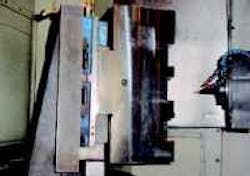Dual vises put the squeeze on setup problems
Impact Forge vertically clamps its 1,500-lb hammer dies for machining in twin Kurt vises that reduce setup times 50% over dedicated fixturing.
Postioning and clamping hammer dies weighing as much as 1,500 lb and measuring up to 24 3 26 3 12 in. is no easy task. That's why Impact Forge Inc. of Columbus, Ind., incorporates a twin-vise setup that efficiently clamps the dies vertically for machining and reduces setup times 50% over dedicated fixturing.
The shop uses two Kurt 640 XLS vises with 14-in. open-jaw capacities and sides accurately machined to within 0.001 in. for precise alignment. Mounted vertically on a die plate, the jaw openings of the vises provide a clear path for lowering the hammer dies with an overhead crane.
"The crane picks up the die on its side and lowers it into the dual-vise fixture," explains Doug Lynch, applications engineer at Impact Forge. A round dowel centered between the two vises acts as a locator and matches up with a dowel pocket in the hammer die to guide/center it in the vise jaws. Operators then manually tighten the vises, release the crane, and re-tighten. "With our previous custom fixturing, positioning the die involved adjusting and tightening several knobs," adds Lynch.
These custom fixtures worked well, but were slow to set up. The shop wanted something it could purchase out of a catalog, so it evaluated different types of vises as well as modular fixturing. In addition, because hammer-die volume expanded, the shop wanted a cost-effective workholding setup it could replicate for another machine.
"Kurt offers a lot of vise sizes, and we were familiar with the company's heavy-duty Anglock design for accurately centering and gripping heavy parts," says Lynch. Applying clamping force to the Anglock design pushes the dies down and onto the base and keeps them from lifting during machining.
Impact Forge considered hydraulic clamping for the setup because it removed some of the human element and chances of error, but decided against it for fear of hydraulic failure. The Kurt vise setup is simple and has worked without problems for over two years at the shop.
Kurt Manufacturing Co.
Minneapolis
kurtworkholding.com
Multitasking machine meets shop's changing workloads
Domino Machine mills, turns, bores, drills, and taps the valve bodies in one setup on its Integrex e-650H machining center with an indexing chuck.
Domino Machine Inc. in Edmonton, Alta., manufactures stuffing boxes and blow-out preventers for the oil and gas industries. Its customers once supplied cut barstock for machining parts, but now want the shop to manage the complete manufacturing process and supply parts turnkey. In addition, customers may need 200 parts, but shipped at 50/month, and if these customers get busy, Domino's workload can quadruple in a moment's notice. To stay competitive, the shop relies on a Mazak Integrex e-650H machining center with an indexing chuck.
The Integrex provides flexibility and quality while letting Domino adhere to stringent delivery schedules. For instance, choke-valve bodies once took days to manufacture and were, thus, special-order items. They are now a standard production item because the shop mills, turns, bores, drills, and taps the valves in one setup on the Integrex.
According to company President Dietmar Sedens and Vice President of Operations Werner Harder, parts, part orders, and raw materials change constantly depending on available barstock, castings, and forgings. This makes it difficult to set up machines for any one job, so machines must be flexible.
"Going from raw material to a finished part in one setup on the Integrex is extremely advantageous," says Sedens. "More than 60% or our work comes from wellhead OEMs, and they require literally thousands of parts in all shapes and sizes," he adds. "Tolerance in lengths might vary by inches while some diameters are held within 0.005 in. for sealing purposes."
Mazak Corp.
Florence, Ky.
mazakusa.com
